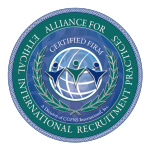Given the present nursing shortage in the country, which has been extensively covered by news organizations and trade publications like U.S. News & World Report and Nurse Journal, among others, foreign-educated nurses might want to think about pursuing a career in the United States. Although there may be severe regulations and immigration laws, the process of switching might be rewarding.
If you wish to work as a nurse in the United States after becoming a registered nurse (RN) in another nation, there are a few things you should consider. Prior to beginning work as a foreign nurse in the United States, there are a few things you’ll need to take care of, however, the specific criteria will depend on the state where you live. Some states will also allow you to work as an independent nurse, so it’s important to understand np independent practice states if you’re looking for this kind of role. Otherwise, you need to look at states where you’ll be working under supervision.
Step 1. Meet the Basic Requirements
As a foreign-educated nurse seeking to work in the United States, make sure you follow U.S. federal immigration law and that you meet the basic educational and/or professional requirements:
- Immigration
In order to legally migrate to the United States, you must meet federal requirements.
You will need to obtain a Registered Nurse Immigrant Visa (“Green Card”) or H-1B visa.
- U.S. law requires nurses to complete a screening program before they can receive an occupational visa.
- CGFNS is approved by the U.S. Department of Homeland Security to validate the credentials of nine foreign healthcare professionals for occupational visas, including registered nurses.
- Completing CGFNS’ VisaScreen®: Visa Credentials Assessment Service will satisfy the screening program requirement.
- You will need a “U.S.-based employer” that will serve as the petitioner for your visa. Your VisaScreen® certificate must be included on every visa or green card petition filed on your behalf.
- Read more about VisaScreen.
- Educational / Professional
In order to seek work as a foreign-educated nurse, you must demonstrate at least some of the following:
- You graduated from an accredited nursing education program in your country of education
- You are licensed as a Registered Nurse in another country
- You’ve practiced as a Registered Nurse for at least two years before.
- Some foreign educated nurses must demonstrate their proficiency with the English language by taking an exam such as the Test of English as a Foreign Language (TOEFL), the Test of English for International Communication (TOEIC) or the International English Language Testing System (IELTS Academic). There are exemptions depending on your country of origin.
Step 2. CGFNS Evaluates your Credentials
State Boards of Nursing require that you first apply to CGFNS International, Inc. to have your academic and professional credentials evaluated to ensure that your documents are authentic and that what you’ve learned is comparable to U.S. nursing standards. You may also be required to take the CGFNS Qualifying Exam® to satisfy State Board requirements, to satisfy immigration requirements for obtaining an occupational visa, and to determine your readiness for a licensure exam.
Find out what CGFNS program you need. Apply to CGFNS.
Step 3. Pass a Licensure Exam
In order to practice nursing in the United States, you will need to have a professional license from the state where you plan to work. Registered Nurse licenses are regulated by State Boards of Nursing with varying requirements.
You will likely need to pass a licensure exam to be registered as a nurse by your state board. Before taking the licensure exam, first-level, general nurses educated outside the U.S. may choose to apply to the CGFNS Certification Program®, which consists of:
- a credentials evaluation
- the CGFNS Qualifying Exam®, and
- an English language proficiency component.
The CGFNS Qualifying Exam® is a requirement by some state boards before you can sit for the NCLEX-RN, but it serves as an excellent predictor for how any nurse will do on that exam. Taking the Qualifying Exam may help gauge your readiness before committing to the licensure exam.
The Qualifying Exam also fulfills the U.S. federal government’s screening requirement for an occupational visa. View the requirements for the board of nursing in the state where you seek to practice
Step 4. Find a Registered Nursing Position
After you meet all federal immigration requirements, have had your credentials evaluated by CGFNS, you meet your State Board of Nursing requirements, and you have passed a licensure exam, you are ready to begin working as a registered nurse in the United States!
While it’s not required, you may choose to work with a nursing recruiter to help you find a registered nurse job. These recruiters can also act as your “U.S.-based employer” for your immigrant visa.
Check to see if your recruiter uses ethical recruiting standards by looking for the Alliance for Ethical International Recruitment Practices Certified Ethical Recruiter seal on their website:
Depending on your home country, the process of applying to work in the United States from overseas may take several years because the country only issues a certain amount of Green Cards to individuals of a given birthplace. Living in the United States, however, typically allows you to start working far sooner than living overseas.
The procedure will go more quickly if you are proactive in setting up the CGFNS Qualifying Exam, the NCLEX-RN, and any required English proficiency examinations in advance. Make sure you plan out what has to be done and how long it will take, and base your expectations on your past experience and the situation.
Read Also: Translation Agency USA
There isn’t any public data about how much foreign-educated nurses make explicitly, but the median salary for registered nurses is $81,220.
| State | Median Salary | Bottom 10% | Top 10% |
|---|---|---|---|
| Alabama | $63,090 | $48,820 | $82,760 |
| Alaska | $102,260 | $80,950 | $127,280 |
| Arizona | $82,330 | $66,040 | $105,520 |
| Arkansas | $64,130 | $37,630 | $83,700 |
| California | $132,660 | $84,700 | $177,670 |
| Colorado | $82,430 | $66,130 | $107,260 |
| Connecticut | $95,210 | $71,050 | $119,600 |
| Delaware | $82,230 | $64,100 | $101,110 |
| District of Columbia | $98,970 | $66,260 | $135,260 |
| Florida | $77,710 | $61,190 | $100,060 |
| Georgia | $79,440 | $60,400 | $118,270 |
| Hawaii | $120,100 | $76,640 | $137,710 |
| Idaho | $77,940 | $61,530 | $100,440 |
| Illinois | $78,980 | $62,180 | $102,080 |
| Indiana | $73,290 | $55,200 | $95,600 |
| Iowa | $65,000 | $56,330 | $83,360 |
| Kansas | $66,460 | $52,010 | $93,120 |
| Kentucky | $75,800 | $56,120 | $98,540 |
| Louisiana | $73,180 | $57,500 | $95,540 |
| Maine | $77,340 | $61,170 | $100,910 |
| Maryland | $83,850 | $64,680 | $106,910 |
| Massachusetts | $98,520 | $67,480 | $154,160 |
| Michigan | $79,180 | $64,270 | $100,920 |
| Minnesota | $84,060 | $65,500 | $107,960 |
| Mississippi | $63,330 | $49,980 | $84,030 |
| Missouri | $71,460 | $51,440 | $94,340 |
| Montana | $76,550 | $62,930 | $98,970 |
| Nebraska | $74,990 | $58,900 | $93,230 |
| Nevada | $94,930 | $74,200 | $130,200 |
| New Hampshire | $80,550 | $62,790 | $104,270 |
| New Jersey | $98,090 | $76,650 | $118,150 |
| New Mexico | $81,990 | $64,510 | $106,300 |
| New York | $100,370 | $64,840 | $132,950 |
| North Carolina | $76,430 | $59,580 | $100,430 |
| North Dakota | $69,640 | $60,780 | $91,150 |
| Ohio | $76,810 | $61,860 | $98,380 |
| Oklahoma | $74,520 | $53,560 | $97,520 |
| Oregon | $106,680 | $81,470 | $131,210 |
| Pennsylvania | $78,740 | $61,450 | $101,450 |
| Rhode Island | $85,960 | $65,260 | $104,790 |
| South Carolina | $75,610 | $52,620 | $93,190 |
| South Dakota | $62,920 | $51,240 | $80,860 |
| Tennessee | $65,800 | $51,270 | $95,490 |
| Texas | $79,830 | $61,950 | $105,270 |
| Utah | $77,240 | $61,850 | $98,000 |
| Vermont | $77,230 | $60,900 | $101,570 |
| Virginia | $79,700 | $61,970 | $104,410 |
| Washington | $101,230 | $77,460 | $131,230 |
| West Virginia | $74,160 | $47,640 | $96,470 |
| Wisconsin | $79,750 | $65,110 | $100,820 |
| Wyoming | $77,730 | $60,910 | $102,010 |
What is the CGFNS Qualifying Exam?
This test is designed to demonstrate that your education has prepared you to safely and effectively practice as a nurse. The exam is given four times each year in over 40 locations worldwide, so you don’t necessarily need to travel to the U.S. to take it.
The qualifying exam is primarily a multiple-choice test that covers key topics in the areas of:
- Effective care management
- Health promotion and maintenance
- Psychosocial integrity
- Physiological integrity
The test takes roughly three hours to complete, and you’ll be able to get your results in about two weeks.
If you pass, you’ll receive a CGFNS Certificate. If you don’t, you can retake the test, but keep in mind that you must pass the English language test and the qualifying exam within two years of each other.
The CGFNS exam can predict your readiness for the NCLEX-RN, which is required by most states. Some states require that you take the CGFNS exam before qualifying to take the NCLEX-RN. Both exams meet the test requirement of the visa credentials assessment that comes next.
Can a Foreigner Work as a Nurse in the USA?
Although it requires time and preparation, there are now options for foreign nationals to immigrate to the United States as nurses due to the present nursing shortage. These are the essential actions to get employment as a nurse in the United States.
Foreign nationals now have the opportunity to work as nurses in the United States due to the present nursing shortage, but the process requires planning and time.
Step 1: Meet basic requirements
To work as a nurse in the U.S., foreign nationals must demonstrate that they have:
- A degree from an accredited nursing education program in their home country
- A Registered Nurse (RN) license in their home country
- Experience as a practicing Registered Nurse for at least two years.
If they graduated from a program where instruction was not done in English, foreign-education nurses will need to demonstrate their English language proficiency.
This can be done by taking the Test of English as a Foreign Language (TOEFL), Test of English for International Communication (TOEIC), or the International English Language Testing System (IELTS).
Step 2: Get your foreign credentials verified
Before sitting for a licensure exam, foreign nurses must get their foreign nursing credentials verified. This process varies by each State Board of Nursing, so make sure to review your state’s specific requirements.
The Commission on Graduates of Foreign Nursing Schools (CGFNS) is a nonprofit organization approved by the U.S. Department of Homeland Security to validate the credentials of international nurses and determine their eligibility to take the licensing exam.
CGFNS has various credentialing services to fulfill different immigration and licensing requirements, but here are a few common services for foreign nurses:
- CGFNS Certification Program is popular for first-level, general nurses educated outside of the U.S. This includes a CGFNS Qualifying Exam®, which is only required by some State Boards, but is also helpful to determine readiness for licensure exams.
- VisaScreen® is also popular because it satisfies all credential verification and language requirements needed to get licensed and obtain a work visa.
Note: while CGFNS is a widely known and accepted nursing certification organization, there are other cheaper options to consider, such as the International Educational Research Foundation and the Educational Records Evaluation.
Make sure to contact the State Board of Nursing in the state you wish to work to determine which certifications they will accept.
Step 3: Pass a licensure exam
To get a nursing license in the state you wish to work, you must pass the National Council Licensure Examination (NCLEX). Through the NCLEX website, you can register for the exam (for a $200 fee), develop a test prep plan, and get your results.
See the NCLEX FAQs for more information on test content, logistics, and preparation
Note: some Boards of Nursing may have exceptions for foreign-educated nurses, such as accepting the Canadian Nurses Association Testing Service (CNATS) or the Canadian Registered Nurses Examination (CRNE) in place of the NCLEX.
Step 4: Find a nursing job
Once you’ve passed the NCLEX, you will need to find an employer to sponsor your work visa. Staffing and recruiting agencies can help tremendously in your search to find organizations with vacancies for foreign nurses. The CGFNS’s approved recruiter list is a good place to start looking for reputable agencies.
The American Nursing Association’s Career Center has helpful tools to find open positions, improve your resume, and prepare for nursing interviews.
Step 5: Get a work visa
While there are many types of work visas in the U.S., there are few common work visas for foreign nurses.
- Registered nurse green card:
A U.S. employer may be willing to sponsor your green card for a full-time permanent position. This is commonly done via the EB-3 Visa for “skilled or professional workers.”
This will involve the labor certification process, commonly referred to as PERM. However, employers are not required to post advertisements about open nursing positions (a typical PERM requirement), since nursing is classified by the USCIS as a “Schedule A” position that needs more workers due to a shortage.
- H1-B:
If you want to work in the U.S. as a nurse on a temporary basis, you may be eligible for an H1-B visa.
To be eligible for an H1-B, a nurse’s employer needs to demonstrate that the nursing position is a “specialty occupation”, meaning a bachelor’s degree or equivalent is typically required for the position. Therefore, only nurses with bachelor’s degrees who are pursuing specialized roles, such as critical care nurses, clinical nurses or nurse practitioners, have strong cases for H1-B visas.
Make sure to check with your employer about the requirements for the registered nurse position in the state where you hope to work. Many states do not require a bachelor’s degree for an RN position and therefore, there is not a strong case for an H1-B in those states.
- TN Visa:
Citizens from Canada and Mexico may be eligible to apply for a TN Visa to work as a nurse in the United States. This visa allows citizens of these two countries to work in the U.S. for up to three years, with the possibility of renewing indefinitely if requirements are still met.
Finally
If you are able to successfully manage the licensing and immigration processes, being a nurse in the United States can be a rewarding career choice. You’re almost ready to begin your life in the United States once you’ve obtained your visa, obtained employment, and passed your licensing exam.



